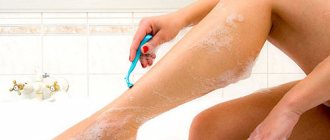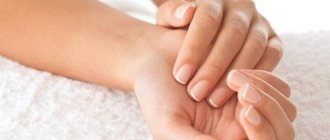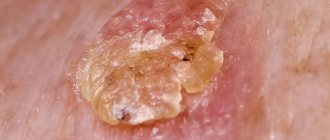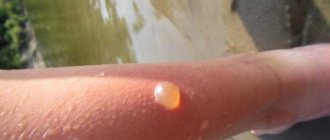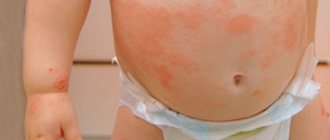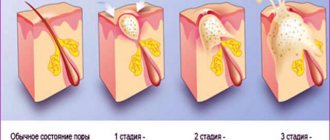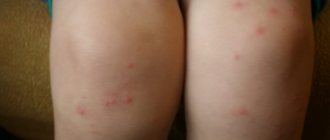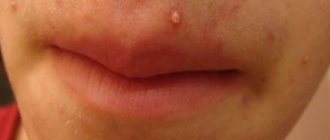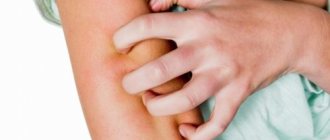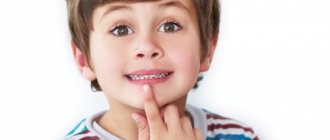Pimples on a child’s body, red rash: what is it, treatment
Rashes on a baby’s body are a common occurrence. The child’s body has not yet adapted to damaging environmental factors and reacts to them in the form of small pimples. It is necessary to pay attention to rashes, as they may indicate the presence of pathology.
The main causes of acne in children
Acne on a child's body can be caused by a number of different reasons. The main ones:
- Teething. During this period, the baby’s salivation increases, and the rash is localized near the mouth or on the cheeks. The skin becomes clear after the process of teeth growth is completed.
- Allergic reaction. If pimples are accompanied by a runny nose, itching or sneezing, we can conclude that the child has an allergy. As a rule, it appears suddenly and requires treatment.
- Prickly heat. Pimples may indicate a special form of dermatitis, which appears due to excessive sweat production or slow evaporation.
- Skin contamination. The skin of a small child is very delicate and sensitive and requires special care. If the contamination is severe, purulent pimples may appear on the baby's body.
- Chapping/sunburn/frostbite. Weather conditions can also affect the condition of the baby's skin, so it is necessary to use special protective products.
- Infection. Pimples on different parts of the baby’s body may indicate an infectious disease (chickenpox, measles, rubella, and so on).
- Insect bites. Single pimples on a child’s body may appear due to insects. To avoid this, it is necessary to use special means against mosquitoes and others. This is important because an insect bite can trigger an allergic reaction.
What can cause acne to form on a child's body?
There are many reasons for the appearance of small pimples.
It is necessary to urgently identify the cause, as it may be quite serious. Do not forget about possible infectious or other diseases, which should be combated immediately.
The reason may be:
- insects;
- weather;
- allergy;
- teething;
- pollution;
- various kinds of diseases.
Acne in a child in the first months of life
Rashes in newborns cause great concern among parents.
Pimples can be on the face or all over the body. This is how newborn acne manifests itself.
Often, even doctors can confuse newborn acne with other types of skin diseases, so you need to know the main differences between acne:
- absence of comedones;
- pimples are located close to each other;
- most often located on the face or back of the head;
- the color is yellowish, pearlescent or whitish.
We recommend: Normal temperature in a child
For a more competent selection of treatment, it is recommended to contact not only a pediatrician and dermatologist, but also an endocrinologist and immunologist.
Pimples in a child in the first years of life
Pimples in a child's first years of life can also be acne, only of a different type - childhood acne. For the most part, this is due to an increased level of testosterone in the baby’s blood.
Boys are more susceptible to childhood acne.
Often pimples at this age are purulent and inflamed, which can result in scars later on.
What are the dangers of purulent acne in a child?
The baby's skin is very delicate and sensitive. Under no circumstances should you squeeze pimples that appear on it and then burn them using alcohol, brilliant green or iodine. If you squeeze out a pimple, it will leave a deep scar, which is much more difficult to get rid of.
Purulent pimples may indicate the presence of serious diseases. Their appearance cannot be ignored.
Advice from Dr. Komarovsky
Evgeny Komarovsky claims that at a certain age, acne is not scary. In adolescents, this phenomenon is considered normal, but if rashes are found in a 6-year-old child, there is reason to think about it.
Dr. Komarovsky's advice on pimples:
- Rinse problem areas 2 times a day, using only your hands. A washcloth or cotton pads can cause even more damage to sensitive skin.
- You can't squeeze pimples.
- It is recommended to pay attention to special means to combat rashes.
- Do not touch the problem area with dirty hands.
- Do not rely on ultraviolet rays; their benefits in this matter are greatly exaggerated.
Komarovsky is confident that any pediatrician is able to identify the cause of acne. However, an attentive mother can do this. When acne appears, it is recommended to remember yesterday - what the child ate, where he went, what he was wearing. Analysis can provide a lot of interesting facts that will help determine the exact cause.
Pimples on a child’s body may indicate a serious pathology, or may only indicate minor flaws in nutrition or hygiene. You must carefully monitor your baby and follow all the rules for caring for him.
Source: https://DetMed.info/pryshhi-na-tele-u-rebenka
Ointments and other drugs
What medications and antibiotic ointments are used for acne on the legs and arms of a child? Let's list the main ones:
Acne on the body of a child without fever
June 30, 01:13
Chickenpox. How it was.
As it turned out, you can study this disease as much as you like, see it on other children and read reviews, but until it passes through your child’s body, you can assume that you don’t know anything.
I didn’t really allow myself to be photographed, so the desired photo chronicle never happened. So, December 5, age 3.8, quarantine due to chickenpox in the group. Knowing that the probability of our illness approaches 100%, I examine Danik every evening after bathing.
Day 1 Barely visible 2 red pimples on the belly... Read more →
Neutropenia (Autoimmune neutropenia of infants, agranulocytosis!) How it happened with us...
I’ve been wanting to write this post for a long time, but I couldn’t get it together. I receive a lot of messages in personal messages and decided to write so that mothers who are faced with this disease know as much information as possible about it.
At one time, I also searched and could find little about real information from mothers whose children have and have had neutropenia. I came across a post here, wrote our questions and our story there, but received no support or information.
Therefore, girls, if you are faced with this disease, can I... Read more →
Watery pimples all over the body and head
The next day I saw pimples all over my body, I decided that it was an allergy, although Musya had never had an allergy before. I put her on a diet and started giving Finestil-Lite a dose. The next day I woke up and was stunned... my whole face, neck and a little bit of my body was covered in acne.
.. Continue reading →
allergy to gluten?
We were diagnosed with an allergy at three months, not by our pediatrician (since she was on vacation). They said it was most likely caused by the foods I ate, and a search began on the Internet about allergies and what they could be.
Firstly, contact – we wash all our clothes, including my husband’s and mine, with “Eared Nanny” powder, and put a filter on the shower. I cut out chicken and eggs from our diet, everything dairy, everything with sugar, everything with gluten. Of course, nothing colored, just green.
The skin has become… Read more →
We go to the doctor if...
Sometimes external signs of illness do not appear or do not appear immediately. Therefore, a visit to the doctor is never superfluous. It is worse to miss a disease than to discover it.
But even if something is wrong, remember that parental love, attention, affection, trust will help the child overcome any illness. To avoid complications of the disease, it is necessary to notice the symptoms of the onset of the disease in time and do everything to eliminate its cause.
There are a huge number of signs of disease, but we will consider only a few of them... Continue reading →
Why does a child have pimples on his stomach?
Girls, this is the question. The child constantly has pimples on his stomach or back. We don’t give antihistamines, it goes away on its own. It started a year ago with terrible hives after OPV drops. Huge spots appeared all over my body, 6 hours after vaccination. We spent a week in the hospital.
Continue reading →
I'm worried about rashes.
Oh, where should I start, I’ll probably start from the very beginning, the child had a fever on Monday night, they called an ambulance, they came and looked, they didn’t see anything special about ARVI, plus the child’s red pimple popped up as if it had been bitten by a mosquito.
I showed it to the doctor and asked if something jumped up, to which she said hmm, well, it’s not a meningococcal rash and that’s it. And they left. The next day, we got two more on the back, and more small little pimples, similar to prickly heat but isolated...
Continue reading →
We got sick, and you be careful
On Friday evening the temperature jumped, it was almost 39. I lit a candle, with difficulty, but slept a little. At night it rose again, in the morning - a candle. On Saturday the doctor on duty was called. Continue reading →
A 1-year-old child has a rash. It doesn’t go away! (((
My baby developed pimples all over his body, mainly on his arms and legs, on his neck and head too. It looked as if mosquitoes had bitten me, so they didn’t pay attention.
But then these pimples swell like a lump and swell up to the size of a 50-kopeck coin, there is pus inside, it is very itchy. The baby scratches and the pus comes out, wounds appear, he also scratches and rips them off. He sleeps poorly, almost climbs on the wall from itching, and cries. No temperature.
How we were treated. First they called a doctor, they told us that it was most likely an allergy... Read more →
Chickenpox..
Like this. This nasty thing suddenly came to us unexpectedly. A few days ago I noticed pimples on the child, mostly on the legs, I thought mosquitoes, because... we walk until late. Didn't attach any importance. Then more appeared, and again I blamed it on the mosquitoes.
We bought fumitox and placed it in our daughter’s room overnight. Well, I haven’t looked for a while, whether there are new ones or not. Yesterday. My daughter is sitting on the potty thinking about life and smelling her foot. I thought, I thought, it happens. We get up, and there the pimples are already scratched out. Then within...
Continue reading →
Rash in a child after urticaria and acute respiratory viral infections ((((
Moms, please tell me if anyone has had this happen: my son is 1.
8 years old, three weeks ago, acute urticaria occurred and angioedema, presumably from raspberries and strawberries, we stayed in the hospital and were treated with prednisolone, diazolin and diphenhydramine, there we were blown away and after discharge we suffered from ARVI for another week, which was treated with anaferon, during a child’s cold a rash began to appear on the body, which was very strange for me, in the form of red spots, the size varies but about 1-2 cm, after a day the redness went away, but the spot turned into a pimple, but the head... Read more →
They diagnosed a sore throat, but it looked like Coxsackie virus
He was very capricious - as I understand it, his body was aching. Yesterday I had no fever, it became painful to eat, my lips were swollen, and then during the day I broke out in a rash on my feet. By the evening - in the mouth - as if the cheeks had been bitten, on the hands - on the fingers on both sides...
Continue reading →
Coxsackievirus in Turkey in a one-year-old child
My baby got sick in September 2014, when we were on vacation in Turkey near Kemer, I looked through the entire Internet in search of similar symptoms. He had a temperature of 39-39.5 for several days, and then acne appeared.
It all started with the fact that in the evening the child first developed a temperature of 38.5, and then quickly crept higher. We didn’t bother making things up and went to the doctor.
A car from the hospital came for us, the doctor examined us and said that our throat was sore, he said that it was most likely a cold or a throat infection and... Read more →
Polycystic ovary syndrome or multifollicular ovaries
Polycystic ovary syndrome or multifollicular ovaries Doctors on ultrasound often see a fairly typical picture, which is called multifollicular ovaries. For some patients, multifollicular ovaries are synonymous with polycystic disease, in which there are also many follicles. Meanwhile, these are completely different concepts.
To begin with, let us describe the ultrasound picture of the ovaries in polycystic disease: the volume of the ovaries is almost doubled (7-9 cm3 or more with the usual size of 4-7 cm3); thickening of the ovarian capsule, which is clearly visible as a more pronounced line along the periphery of the entire ovary (the thickness of the capsule can reach quarter of the visible diameter of the ovary); by...
Continue reading →
What do pimples on a child's bottom mean?
A child’s body has a fairly weak immune system, so any rashes and even pimples on a child’s bottom can be a sign of either an allergy or some kind of disease.
But if this is a disease, then it is accompanied not only by rashes, the child also has other symptoms, fever, pain, general lethargy and... Read more →
Coxsackievirus in Turkey in a one-year-old child
My baby got sick in September 2014, when we were on vacation in Turkey near Kemer, I looked through the entire Internet in search of similar symptoms. He had a temperature of 39-39.5 for several days, and then acne appeared.
It all started with the fact that in the evening the child first developed a temperature of 38.5, and then quickly crept higher. We didn’t bother making things up and went to the doctor.
A car from the hospital came for us, the doctor examined us, said that our throat was sore, said that it was most likely a cold or a throat infection and prescribed... Read more →
This is a misfortune, a virus or stomatitis (for the impressionable)
The child developed these pimples around his lips, it all started with one, and began to increase every day (huge, red, and white in the middle). Today we saw the pediatrician, she said it was a virus (ente..
-virus, I don’t fully remember the name here) She said there’s something like this going around the city right now. They can be all over the body, in the mouth, in the throat, which can cause a fever and diarrhea.
It turns out that we also have it in our throats, and in the evening they appeared on the tongue and in the mouth behind the lips. At… Read more →
Baby dowry
Source: https://www.BabyBlog.ru/theme/pryschi-na-tele-u-rebenka-bez-temperatury
Diseases accompanied by rashes
For a child’s body, a rash is a very important symptom of the manifestation of certain diseases, which is why consulting a doctor is so important, because only he can give a competent description and explanation of the pathological process. The etiology of rashes can be completely different.
Dermatological diseases
Before treating a rash on a child’s body, you need to establish the exact cause of its appearance. The etiology of rashes can be associated with both infectious and non-infectious diseases.
Prickly heat
Quite often diagnosed in infants, which is associated with clogging of the sweat glands. If normal sweating is disrupted, the glands become clogged, the skin becomes bright red, and a pinpoint rash appears.
Most often, prickly heat occurs on poorly ventilated areas of the skin (the neck area, axillary and inguinal folds). There is no increase in temperature, the itching is minor. This condition must be treated without delay, because after several days of inactivity, the child’s entire body will be affected. A good prevention of prickly heat is regular airing of the room, bathing children in baths with the addition of string and chamomile. It is better to treat diaper rash not with baby cream, but with powder. If all the doctor’s recommendations are followed conscientiously, the child’s redness disappears after a few days.
Heat rash on the face of a baby
Eczema
The etiology of this disease is associated with many endo- and exogenous factors. It can also manifest itself according to genetic predisposition. The rash has a dark purple hue, usually appears on the side, on the folds of the arms and legs, and less often on the face and neck. With eczema, intense itching and flaking are observed. The treatment regimen depends on the stage of the disease. To alleviate the baby's condition, lotions, compresses, ointments and solutions are prescribed. All allergenic foods must be excluded from the mother’s diet; the child should be dressed only in underwear made from natural materials.
Allergic rash
A rash appears in a child due to allergens. This is the most common cause of rashes in childhood. Allergens can include medications, food, and pet hair (hamsters, cats, dogs, guinea pigs, etc.). They can trigger a severe allergic reaction, which includes:
- severe lacrimation;
- itching in the nasal cavity;
- conjunctivitis;
- sneezing;
- cough.
Allergic rash in a newborn
Infectious rash
If the rash accompanies an infectious disease, the body temperature will certainly increase. Below are some diseases that will be accompanied by a rash.
Chickenpox
This is a widespread disease. The first sign of pathology is the appearance of red spots, which quickly transform into the blistering stage. In addition to blisters on the face, head, and body, there is also a rash on the upper and lower extremities. The child's basal temperature is elevated, and the baby may experience weakness and headache for some time.
Rubella
Patients present with fever. Children complain of joint pain, as well as general intoxication. A small rash first appears on the face, then spreads throughout the body.
It should be noted! The younger the child, the easier this pathology occurs. Adolescents may experience complications such as encephalitis or meningoencephalitis. Rubella is especially dangerous for pregnant women, as there is a high probability of developing defects in the fetus.
Acne in a child: treatment, symptoms, causes, prevention, types, photos
On their own, at home, it will be very difficult for parents to determine why red pimples broke out on their child’s body.
They can only analyze their baby’s lifestyle and menu, which may cause this irritation.
If the reason lies in malfunctions and disruptions in the functioning of various systems of a small body, it is better to consult a doctor as soon as possible for a timely diagnosis. Among the factors that provoke the appearance of a rash are:
- teething (accompanied by copious salivation);
- diaper rash;
- reaction to vaccination;
- failure to comply with basic hygiene rules;
- low-quality clothing made from synthetic materials;
- overheating of the skin (if too many things are put on the baby and he becomes hot), resulting in prickly heat (in the hospital, such pimples are called milliaria);
- allergies (it is necessary to identify what the baby reacts to so violently in order to exclude his contact with this object or animal);
- diseases such as scarlet fever (accompanied by fever), chickenpox (fever), measles (a cough is added to the rash);
- streptoderma;
- infectious inflammation of the skin;
- dyshidrosis;
- molluscum contagiosum;
- enterovirus;
- external environmental factors: chapping, sunburn or frostbite, insect bites;
- acneiform rash in infants whose mother took certain medications during pregnancy: steroids, medications with lithium or phenytoin.
If you notice red pimples on your child's face, tummy and other parts of the body, try to understand why this could be happening. If there are no obvious reasons, be sure to seek medical help at the hospital. After all, treatment will most directly depend on what kind of rash covers your baby’s body.
Kinds
The most common acne on the face of children are:
- colds: their appearance is due to a general decrease in the body’s immune system due to a cold;
- teenage acne.
To treat cold acne, you need to consult your doctor in time, thereby beginning to relieve cold symptoms.
The effectiveness of acne treatment depends on the time of starting the course of treatment for a cold. As a rule, doctors prescribe complex treatment, using various ointments and brilliant green for acne.
Types of rash
Red pimples that appear in a child on the face (most often on the cheeks and around the mouth) and on the body (on the arms and legs, on the butt, on the back, on the stomach) may look different.
For some, they may present as localized lesions that resolve within a few days. In others, they can cover most of the body and over time only grow and become even more inflamed.
These may be rashes such as:
- small pale red pimples on the chin, gradually turning into one continuous inflamed spot - this is due to excessive salivation during teething;
- red, watery pimples on a child’s body can be a symptom of chickenpox: at first, single tumors become more and more numerous;
- pimples on the butt - from diaper rash due to a diaper;
- if a black dot can be seen in the center of the water pimples, molluscum contagiosum will most likely be diagnosed;
- pimples mainly spread exclusively to the arms (palms) and legs (feet) of the baby and appear in the off-season (spring and autumn) - we are talking about dyshidrosis;
- a pink-red spot, which after a few hours turns into watery pimples, is a sign of streptoderma;
- small red pimples on a child’s body are heat rash due to lack of fresh air for the skin.
To avoid complications, the diagnosis must be carried out by a doctor, even if at first it seems to you that the red pimples on your child’s body are about to go away on their own. And even more so, you should not self-medicate, which will only worsen the situation. Qualified medical care is what your baby needs in this situation.
Discolored pimples
Newborn acne is red pimples with a white tip that often appear on the face of babies, sometimes on the back or chest. They appear when there is an excess amount of mother’s hormones in the baby’s body. They disappear on their own in the first six months of life and do not require any special treatment.
Milia. They go away on their own, but if they become inflamed, you should seek medical help. This happens due to improper care by parents, for example, when squeezing or smearing with inappropriate cream.
Allergies - small rashes covered with a flaky crust, often itchy and cause trouble for the baby. For recovery it is necessary to exclude the allergen.
Miliaria is a small rash on the butt, armpits, and neck folds.
For various pathologies, skin manifestations have a certain appearance:
- Single rashes in the form of papules with clear liquid are characteristic of chickenpox. The red spots dry out within a few days and crusts form.
- Blisters with a matte tint and a scarlet rim, merging into large areas are a sign of an allergy.
- Scarlet nodules about 1-3 mm containing cloudy exudate occur with prickly heat. The pathology is not limited to infants; it is also observed in older children in hot weather.
- Target-like pimples with a dark red center and a lighter ring are characteristic of exudative erythema.
We invite you to read what acne on the face says
Babies have small pink pimples near the chin - irritation due to the excessive secretion of saliva during teething.
How to treat
The main treatment for rashes on a child’s body is to treat the underlying disease that caused them. In parallel with this, external medications are prescribed in order to somehow alleviate the itching, burning sensation and prevent the formation of ulcers in the future. Drug treatment involves prescribing the following drugs.
- Bepanten cream and powder if the cause of pimples is diaper rash.
- Bathing in a weak solution of potassium permanganate. The doctor may instead recommend adding decoctions of anti-inflammatory medicinal herbs to the bath - chamomile, string, calendula, oak bark, etc.
- If pimples are caused by an allergy to some food product, a special diet will be prescribed for the mother if the baby is breastfed, or for the baby himself if he is “artificial.”
- Washing and wiping pimples on the child’s body with a solution of furatsilin.
- Antihistamines.
- If we are talking about scarlet fever, antibiotics may be prescribed.
- Zelenka and antipyretics are prescribed for chickenpox.
- In order for the skin to recover faster after pimples, vitamin therapy is carried out.
- If the situation is too serious, doctors may decide to hospitalize the baby.
If everything is done in a timely manner, competently, in accordance with the recommendations of doctors, you can speed up the baby’s recovery without any side effects or complications. Parents should always remember that the baby’s skin is an indicator of his health, so any pimples on it should be treated immediately, finding out their cause and eliminating it.
New articles
we are in social networks
Having discovered red pimples on a child’s body or face, parents often think that this is a common allergy.
But the rash does not always appear in response to an irritant.
Children's immunity is unstable and is formed through exposure to viruses and bacteria.
- All information on the site is for informational purposes only and is NOT a guide to action!
- can give you an ACCURATE DIAGNOSIS !
- We kindly ask you NOT to self-medicate, but to make an appointment with a specialist !
- Health to you and your loved ones!
The causes of the rash can be serious infections, which are very dangerous if left unattended.
Etiology of the problem
A rash is a pathological change in the skin. Skin rashes in a child can be primary or secondary. The combination of different factors determines the picture of the rash in a particular pathology. This may be a reaction to some kind of allergen, or it may turn out that a rash in a child is a sign of some kind of disease.
In the first three months of life, a rash in newborns is a common occurrence, as it is caused by the development of hormonal changes in his body. Pediatricians call this condition “neonatal acne.”
Small red pimples are localized throughout the body (face, neck, legs, shoulders, back, butt, stomach).
Advice. For hormonal rashes, the skin should not be treated with alcohol, potassium permanganate or talc. Also, do not take antibiotics or antiallergic medications. You can help your baby by daily bathing in boiled water (temperature is about 37-38 degrees). If the child is covered all over with a rash, he needs to be shown to specialists.
The etiology of the rash in infants 3 to 6 months of age may be related to acne. This is an inflammatory disease of the sebaceous glands. You can't do this without the help of a pediatrician. He must prescribe treatment and monitor the results.
Allergies and insect bites are only part of the causes of rashes
Traditional treatment
The medicinal industry provides a considerable selection of drugs to get rid of acne: special bactericidal lotions and shower products. Lotions should be applied directly to those areas where there are rashes. But scrubs can be used no more than twice a week.
READ ALSO: A ball in the shape of a bump jumped up on my butt
After cleansing and water procedures, anti-inflammatory creams and gels should be applied to the skin. You can use well-known folk methods to get rid of rashes. Herbs have a wonderful effect. You can make lotions and baths with a decoction of plants. Eliminate scented soap from your care products, replacing it with tar soap. This soap perfectly disinfects and makes the skin drier, controls the process of the sebaceous glands. Here are some effective folk methods of treatment.
Rash in a child without fever and itching, rash with itching: what to do
A rash on a child’s body can appear at any age. In some cases this is a consequence of overheating and poor hygiene, in others it is evidence of disease.
Regardless of the baby’s well-being, even if itching and rashes appear on the child’s body without fever, you should consult a doctor and find out the reasons for the appearance of these symptoms.
Before contacting the clinic, you should not use any medications.
Rash in newborns
The appearance of pimples in infants is not uncommon. In most cases they go away on their own, but you need to make sure there is no serious problem. The most common diseases encountered in medical practice are:
Erythema toxicum
The baby's body is covered with red spots or white-yellow papules with a pink rim. The degree of severity varies: from a few pimples to completely covering the body except the palms and soles. The disease manifests itself most clearly on the second day after birth and goes away on its own.
Acne in newborns
Acne appears 3 weeks after birth and can remain for up to six months. Papules often cover the face, less often the area of hair growth. They do not require treatment, you just need to keep your face clean and moisturize your baby’s skin. Acne in newborns goes away without a trace.
Prickly heat
At any time of the year, a child may develop a rash and itching due to insufficient hygiene and the wrong choice of clothing. When you sweat, it becomes difficult for the sweat glands to release their products and the pores become clogged. Not only the areas of diaper rash are affected, but also the head. Miliaria goes away quickly if the skin is kept clean and treated with powder or cream.
Insect bites
Areas of skin damage caused by insects usually itch and may raise suspicion of an infectious disease. The child, trying to reduce the itching, scratches the pimples until wounds form. This is dangerous, as the likelihood of infection increases.
Swelling, redness, and pain when pressed appear at the site of the bite. The whole body can react. The baby's lymph nodes near the bite site become enlarged, the temperature rises, the heartbeat quickens, and dizziness appears.
Allergic reactions
The causes of allergies are internal and external: food, medications, diapers, detergents, care cosmetics, cold. In this case, a small red rash that appears on the child’s body itches and disrupts sleep and reduces appetite. Acne usually appears on the cheeks, buttocks, and legs, but rashes can occur throughout the body.
There are acute and chronic forms. If the itchy rash does not go away within a month and a half, the baby becomes tired and loses weight.
Scabies
With scabies, the rash in a child is itchy and appears as paired small blisters with a red edge. First they appear between the fingers, on the flexor side of the wrists, then the feet, armpits, and elbows are affected.
The temperature does not rise, but there is an unbearable itching that intensifies at night.
Autoimmune diseases as a cause of rash without itching
If a small red rash on a child’s body does not itch, it may indicate systemic connective tissue diseases. Let's consider the pathologies that occur most often.
Scleroderma
Red spots or plaques appear all over the child's body. They are arranged in a chaotic manner and do not cause itching or fever. Then the skin in these areas may atrophy.
lupus erythematosus
A rash appears in a child without fever or itching; the child’s body is mainly affected in open areas of the body. The disease is dangerous because the joints, heart, and kidneys are simultaneously affected. It is impossible to determine the pathology on your own. Rashes tend to appear in different forms. These can be small pimples, large plaques, or fluid-filled blisters.
Vasculitis
In pathology, the walls of large and small vessels are affected. The body reacts to changes with rashes. Vasculitis is a disease of various kinds in which the child’s rash does not itch and his general condition does not change. In the hemorrhagic form of the disease, in particular, rashes appear on the legs and intensify when the baby is in an upright position.
The main causes of autoimmune diseases are heredity, poor environment, taking certain medications by a woman during pregnancy, and low immunity.
Differential diagnosis of rash of infectious origin
Skin lesions due to infectious diseases are usually accompanied by fever and severe itching. There are a lot of pathologies in this group. Let's highlight the most common ones:
| Disease | Nature of the rash | Other symptoms | Consequences of the rash | Localization location |
| Scarlet fever | Small red dots. |
| Peeling. | The most pronounced rash is on the child’s neck, on the face (except for the nasolabial triangle), and in the folds of the skin. It does not spread as intensely throughout the body. |
| Rubella | Small pink spots. |
| No. | On the first day, the rash appears on the face, on the second and third it spreads throughout the body. |
| Measles | Bright pink tubercles. |
| Peeling, darkening. | On the first day, the rash appears along the hairline, behind the ears. In three days it covers the entire body. |
| Chicken pox | Bubbles with clear liquid. |
| If you make sure that the child does not scratch the pimples, there will be no marks left. Otherwise, scarring is possible. | First, a rash appears in the child’s hair and does not itch much, then it spreads throughout the body. |
| Meningitis | Bruises of different sizes. |
| Traces in the form of scars may remain. | The rash spreads over the torso and legs. |
The baby may have a fungal infection, which is caused by severe sweating of the feet and hands. Red spots appear between the fingers, and small pimples appear along the extremities. It is necessary to diagnose the disease and begin treatment immediately, otherwise the fungus will later become chronic if the parents realize what’s going on too late.
A rash in a child that requires immediate medical attention
Often parents do not understand why a rash appears all over the child’s body without fever and does not itch, but they begin to use medications or traditional medicine. In many cases this is unacceptable. A doctor should be called if symptoms are severe:
- severe swelling and difficulty breathing,
- heat,
- confusion,
- coughing,
- weakness,
- vomit,
- the appearance of spider veins.
What not to do if your child has rashes
So that the doctor can accurately determine the causes of the rash, before his arrival, you should not lubricate the affected area with a bright-colored composition. In addition, no matter how itchy the pimples are, they should not be squeezed or opened in any way. It is strictly forbidden to give your child drugs at your own discretion.
Why does a child have a small rash with fever?
Most often, the rash on a child’s body is itchy and accompanied by high fever due to infectious diseases. But allergies can cause the same reaction.
You cannot start treatment on your own, even if you have managed to bring down the temperature. You need to call a pediatrician or an ambulance at home.
Why does a child have a small rash without fever?
Without an increase in temperature, small pimples of any nature may appear. It is impossible not to pay attention to them.
In this way, the body can send a signal about diseases of the internal organs (liver, thyroid gland, stomach, blood vessels).
Therefore, the most reasonable decision in the event of a rash on the body of a child without fever with itching would be to contact the clinic for qualified help and diagnosis of the disease.
Types of rash
Doctors distinguish several types of rashes on a child’s body:
- Tubercles. Bandless formations that are localized deep in the dermis. The diameter of the neoplasms is from 0.5 to 1 cm. They leave ulcers and scars on the skin. It becomes dry, and its relief and color change.
- Blisters. They usually occur as a result of an allergic reaction and go away on their own within a few minutes or hours after they appear. Observed with insect bites, nettle burns, urticaria, toxicoderma. They pass without a trace, sometimes they itch.
- Bubbles - have a bottom, a tire, a cavity. After opening them, erosion may form and the skin becomes rough.
- Nodules. Characterized by changes in color, texture and consistency of the skin. Dimensions range from 1-3 mm to 1-3 cm in diameter. Accompanying psoriasis, lichen planus, atopic dermatitis, warts, papillomas, eczema.
- Pustules or pustules. Their cavity contains purulent exudate. They can be both deep and superficial.
- Roseolas are spots of an indeterminate shape, pink in color. When the skin is stretched, the spots disappear.
The symptoms of chickenpox are difficult to confuse with the symptoms of any other infection.
